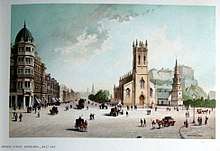Church of St John the Evangelist, Edinburgh

The Church of St John the Evangelist is a Scottish Episcopal church in the centre of Edinburgh, Scotland. It is sited at the west end of Princes Street at its junction with Lothian Road, and is protected as a category A listed building.[1]
Background
It was dedicated as St John's Chapel on Maundy Thursday 1818 with construction having begun in 1816. It was designed by the architect William Burn[2] the previous year, at the remarkable age of only 25.
The congregation had begun in 1792 when Daniel Sandford came to Edinburgh to minister on Church of England lines. In 1797 the Qualified congregation moved to Charlotte Chapel which was re-built on larger lines in 1811. They sold shares to fund a new church, the banker Sir William Forbes being the main figure, while Charlotte Chapel was sold to Baptists.
Edward Bannerman Ramsay went to St John's as curate in 1827. He succeeded Bishop Sandford as minister in 1830, and stayed till his death in 1872, being dean from 1846.
The sanctuary and chancel were built in 1879–82 by John Dick Peddie and Norman Boyd Kinnear. The vestry and Hall in 1915 to 1916 by John Dick Peddie and Forbes Smith.
St John's holds daily services and is unique in that it is the last church in Scotland to hold the weekly service of Matins.
Description
.jpg)
The plaster ceiling vault is derived from that found in the Henry VII Chapel in Westminster Abbey.
Stained glass is largely by Ballantine, but the east window is by William Raphael Eginton.[3]
The morning chapel was furnished by Walker Todd in 1935.
List of rectors
- 1804–1830: Daniel Sandford
- 1830–1872: Edward Bannerman Ramsay
- 1873–1883: Daniel Fox Sandford
- 1883–1909: George James Cowley-Brown
- 1909–1919: George Frederick Terry
- 1919–1926: James Geoffrey Gordon
- 1927–1939: Charles Henry Ritchie
- 1940–1947: Sidney Harvie-Clark
- 1947–1961: David Brownfield Porter
- 1962–1969: Keith Appleby Arnold
- 1969–1981: Aeneas Mackintosh
- 1982–1997: Neville Chamberlain
- 1998–2012: John Andrew Armes
- 2013–date: Markus Dünzkofer (inducted 11/02/2013)
Memorials
- General Sir John Campbell, 2nd Baronet of New Brunswick, Canada
- Sir Henry Raeburn
- Dean Edward Bannerman Ramsay (a tall granite Celtic cross by Robert Rowand Anderson of 1878 with Celtic bronze reliefs by Skidmore, facing Princes Street just east of the church)
Graveyard
- Rev Archibald Alison and his son William Pulteney Alison
- Sir William Arbuthnot, 1st Baronet
- Lesley Baillie subject of Robert Burns' poem "Bonnie Lesley"
- Thomas Balfour (1810–1838), MP for Orkney and Shetland
- George Joseph Bell (1770–1843), legal author
- General Sir Archibald Campbell, 1st Baronet (1769–1843)
- William Campbell, Lord Skerrington (1855–1927), Senator of the College of Justice 1908-9
- Sir James Clerk of Penicuik (1812–1870)
- James Donaldson (1751–1830), founder of Donaldson's School for the Deaf
- Andrew Duncan (1773–1832)
- Daniel Ellis (botanist) (1772–1841)
- Sir William Forbes's son George Forbes (died 1857)
- Prof Sir William Hamilton, 9th Baronet (1788–1856), metaphysician (stone moved and used as edge paving in the eastern enclosure)
- Prof Thomas Laycock (physiologist) (1812–1874)
- General Anthony MacRae (1812–1868), with bronze by Sir John Steell
- Sir Hugh Bates Maxwell and Sir William Maxwell, 9th and 10th Baronets of Calderwood (within the eastern enclosure)
- George Moir (1800–1870), lawyer and essayist
- John Shank More (1784–1861)
- Macvey Napier (1776–1847)
- Margaret Outram (1778–1863), widow of Benjamin Outram
- Dean Edward Bannerman Ramsay (buried distant from the memorial on Princes Street (see above) with a separate monument)
- Bishop Harry Reid (died 1943)
- Anne Rutherford (mother of Sir Walter Scott)
- Daniel Fox Sandford (1831–1906), Bishop of Tasmania, son of Daniel Sandford (bishop of Edinburgh), founder of the church.
- Catherine Sinclair (1800–1864), author
- Prof James Syme (1799–1870), surgeon
- William John Thomson (1771–1845), American-born artist, member of the Royal Scottish Academy
- James Walker (1781–1862), civil engineer
- Bishop James Walker (1770–1841)
- George Young, Lord Young (1819–1907)
Edinburgh City Centre Churches Together
St John's is one of three churches which form Together, an ecumenical grouping in the New Town of Edinburgh. The others are St Andrew's & St George's West and St Cuthbert's.[4]
Just Festival
The church is also home to Just Festival (formerly known as the Festival of Spirituality and Peace) which takes place each August alongside the Edinburgh Festival Fringe.
References
- ↑ "St John's Church (Episcopal): Listed Building Report". Historic Scotland. Retrieved 29 June 2011.
- ↑ Memorials of the church of St. John the evangelist, Princes street, Edinburgh. George Frederick Terry. 1918
- ↑ Buildings of Scotland: Edinburgh, by Gifford McWilliam and Walker
- ↑ Together Trust Archived 22 January 2014 at the Wayback Machine.
External links
- Church Website
- Church Choir Website
- St. John's on ScotlandPlaces
- The Episcopal Congregation of Charlotte Chapel, Edinburgh, 1794–1818. University of Stirling PhD Thesis by Eleanor M Harris
Coordinates: 55°57′00″N 3°12′22″W / 55.9500°N 3.2061°W